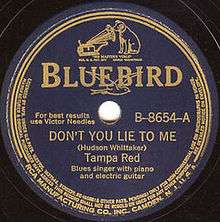Don't You Lie to Me
"Don't You Lie to Me" (sometimes called "I Get Evil"[1]) is a blues song recorded by Tampa Red in 1940.[2] It became a standard of the blues, with recordings by various artists.[3] The song was also interpreted by rock and roll pioneers Fats Domino and Chuck Berry.
| "Don't You Lie to Me" | |
|---|---|
 | |
| Single by Tampa Red | |
| B-side | "Anna Lou Blues" |
| Released | 1940 |
| Recorded | Chicago, May 10, 1940 |
| Genre | Blues |
| Length | 2:55 |
| Label | Bluebird |
| Songwriter(s) | Hudson Whittaker a.k.a. Tampa Red |
Original song
"Don't You Lie to Me" was recorded by Tampa Red approximately midpoint in his prolific recording career, representing the transition from his earlier hokum recordings to his later early Chicago-blues combo style.[4] This was the same period when he began playing the electric guitar and recorded his best-known blues classics, including "It Hurts Me Too", "Love with a Feeling", and "Anna Lou Blues", the B-side of "Don't You Lie to Me".[4]
The song is a mid-tempo twelve-bar blues that features Tampa Red playing jazz-inflected single-note guitar fills behind his vocals. Blind John Davis provided the piano accompaniment with an unidentified bass player and, as a throwback to his earlier days, Red added a twelve-bar kazoo solo.[4] Although many later versions are credited to other artists, they usually use some, if not most, of Tampa Red's lyrics:
There're two kind of people I just can't stand
And that's a lying woman and a sneakin' man
So don't you lie to me, don't you lie to me
Because it makes me mad, and I get evil as a man can be
Recordings by other artists
Fats Domino recorded "Don't You Lie to Me" early in his career in 1951 (Imperial 5123).[3] He used most of Tampa Red's lyrics and, although there is a full backing band, his trademark piano accompaniment dominates the recording. Domino received sole credit for the song, as did Chuck Berry when he recorded a rock and roll version for his 1961 album New Juke-Box Hits.[3] The Rolling Stones recorded Berry's version in 1964, which was not released until their Metamorphosis album in 1975; in 1972 they performed the song in concert. The Pretty Things also recorded Berry's version for their 1965 self-titled debut album.
In 1962, Albert King recorded "Don't You Lie to Me" as "I Get Evil" (Bobbin 135), which was included on his first album The Big Blues.[5] King's version uses an Afro-Cuban style rhythm, which he would later use for his 1967 hit "Crosscut Saw". Later, King with Stevie Ray Vaughan recorded it live for television in 1983, which is included on Albert King with Stevie Ray Vaughan in Session.[6] In 1977, B.B. King recorded the song for his King Size album. Gary Moore recorded it using both titles "Don't You Lie to Me (I Get Evil)", which follows Albert King's version, for his 1992 After Hours album. The Flamin' Groovies also recorded a version of the song, which was released as a single in the UK in 1976. Supertramp also recorded it for their Live '88 album.
Notes
- "Evil" by Howlin' Wolf is a different song.
- Russell, Tony (1997). The Blues: From Robert Johnson to Robert Cray. Dubai: Carlton Books Limited. p. 13. ISBN 1-85868-255-X.
- Herzhaft, Gerard (1992). "Don't You Lie to Me". Encyclopedia of the Blues. Fayetteville, Arkansas: University of Arkansas Press. p. 445. ISBN 1-55728-252-8.CS1 maint: ref=harv (link)
- Fancourt, Les (1994). It Hurts Me Too – The Essential Recordings of Tampa Red (Album notes). Tampa Red. Indigo Records. pp. 2–3. IGOCD 2004.CS1 maint: ref=harv (link)
- "Albert King: The Big Blues – Album review". AllMusic. Retrieved January 7, 2016.CS1 maint: ref=harv (link)
- Erlewine, Stephen Thomas. "Albert King/Stevie Ray Vaughan: In Session – Album review". AllMusic. Retrieved January 7, 2016.CS1 maint: ref=harv (link)